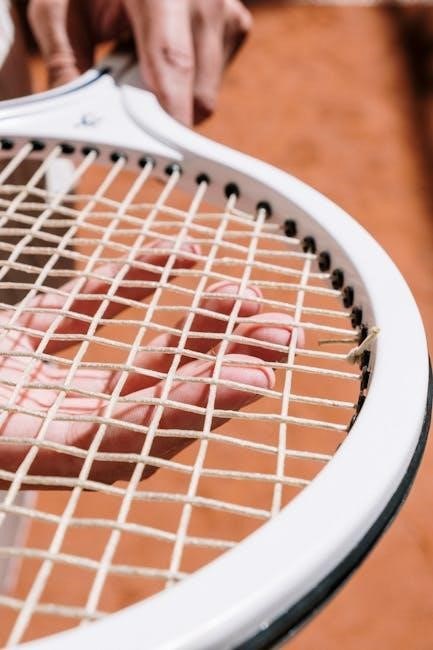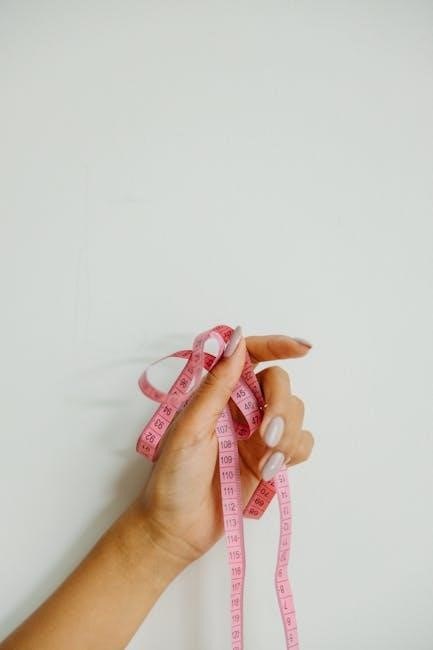Choosing the right tennis racquet grip size is crucial for comfort, performance, and injury prevention. This guide provides a comprehensive overview of grip sizes, measurement methods, and adjustment techniques. Understanding these factors will help players select the ideal grip for their hand size and playing style.
Understanding Tennis Racquet Grip Sizes
Tennis racquet grip sizes refer to the circumference of the racquet handle, impacting a player’s hold and stroke mechanics. Sizes range from 4 inches to 4 3/4 inches, influencing comfort, control, and power. A grip too small can cause excessive wrist movement, while a large grip restricts wrist action. Finding the right fit is essential for optimal performance.
Grip sizes are typically measured in inches or millimeters. Variations can be subtle, with increments of 1/8 inch making a difference. The grip size number, often found on the racquet’s endcap, corresponds to the circumference. Most adult women use a 4 1/4 inch grip, while men favor 4 3/8 inches. Juniors require smaller sizes.
The ideal grip size allows for a comfortable and secure hold, enabling proper stroke execution. It promotes efficient power transfer, reduces strain on the wrist and elbow, and minimizes the risk of injury. Factors like hand size, playing style, and personal preference contribute to determining the most suitable grip size for each player.
Grip Size Measurement: Inches and Numbers
Tennis racquet grip sizes are indicated using two primary systems: inches and numbers. In the United States, grip sizes are commonly listed in inches, representing the handle’s circumference. Elsewhere, a numbered system is used, with sizes ranging from 0 to 6. Size 0 equates to 4 inches, with each subsequent number increasing by 1/8 inch.
Understanding the correlation between inches and numbers is crucial for selecting the correct grip. A size 3 grip, for example, corresponds to 4 3/8 inches; Many racquets display both measurements on the endcap. Converting between the two systems is straightforward using a conversion chart. This ensures players can accurately identify their preferred grip size regardless of the notation used.
Measuring your hand is essential for determining the appropriate grip size. This can be done by measuring from the bottom lateral crease of your palm to the tip of your ring finger. This measurement, in inches, corresponds directly to the grip size. Alternatively, you can use the “pinky finger test,” described later, to assess fit.
How Grip Size Affects Performance
Grip size significantly impacts a player’s control, power, and comfort. A grip that’s too small can lead to excessive wrist movement, increasing the risk of wrist injuries. Players may also compensate by gripping the racquet too tightly, leading to fatigue and reduced control. Conversely, a grip that’s too large can limit wrist mobility, hindering spin generation and maneuverability.
The ideal grip size allows for a relaxed yet secure hold. This promotes proper stroke mechanics, enabling players to generate power efficiently. A comfortable grip also reduces the likelihood of blisters and calluses. Selecting the correct grip size is critical for maximizing performance and minimizing the risk of injury.
Moreover, grip size influences a player’s ability to change grips quickly and effectively. A properly sized grip allows for seamless transitions between forehand, backhand, and serve grips. This is essential for adapting to different situations during a match. Ultimately, finding the right grip size is a key element in optimizing a player’s overall game.

Determining Your Ideal Grip Size: Palm Measurement Method
One of the most reliable methods for determining your ideal grip size involves measuring your palm. Begin by extending your dominant hand, keeping your fingers close together. Use a ruler or measuring tape to measure the distance from the bottom lateral crease of your palm (the crease that runs across your palm) to the tip of your ring finger.
This measurement, typically expressed in inches, corresponds to a specific grip size. For example, a measurement of 4 1/8 inches corresponds to a grip size of 1, while a measurement of 4 3/8 inches corresponds to a grip size of 3. Refer to a grip size conversion chart to accurately determine your corresponding grip size.
This method provides a personalized approach to grip selection, taking into account the unique dimensions of your hand. It’s a simple yet effective way to narrow down your grip size options. While other methods exist, the palm measurement method is widely recognized as a reliable starting point for finding the perfect grip fit.

The Pinky Finger Test: Checking Grip Size Fit
The “pinky finger test” is a practical way to assess the fit of a tennis racquet grip after you’ve narrowed down your options. To perform this test, grip the racquet with your dominant hand using your regular forehand grip. Observe the space between your fingertips and the base of your palm (the thenar eminence).
Ideally, you should be able to comfortably fit the index finger of your non-dominant hand in this space. A snug fit is desired; your finger should neither be forced in nor have excessive room to move around. If you can’t fit your index finger at all, the grip is likely too small. Conversely, if there’s a large gap, the grip is likely too large.
This test helps ensure that your hand can comfortably wrap around the grip without feeling constricted or overwhelmed. The pinky finger test provides a quick, on-the-court assessment of grip size suitability, helping you fine-tune your choice for optimal comfort and control. Remember that personal preference plays a role, so trust your feel during this test.
Common Grip Sizes for Men, Women, and Juniors
While individual hand sizes vary, there are general trends in grip sizes among different demographics. Men commonly use grip sizes 4 1/4″ (size 2) to 4 3/8″ (size 3). Women often find that grip sizes 4 1/8″ (size 1) to 4 1/4″ (size 2) are more suitable due to smaller hand dimensions. However, some women with larger hands might also prefer a 4 3/8″ (size 3) grip.

Junior players have a wider range of grip sizes depending on their age and hand size. Younger juniors typically use smaller grips, ranging from 4″ (size 00 or 0) to 4 1/8″ (size 1). As they grow, they gradually transition to larger sizes. It’s essential to measure a junior player’s hand to ensure they’re using an appropriately sized grip for optimal control and development.
These are general guidelines, and individual preferences should always be considered. Players should try different grip sizes to determine what feels most comfortable and allows for proper stroke mechanics. Consulting with a tennis professional can also provide personalized recommendations.
Adjusting Grip Size: Overgrips and Heat-Shrink Sleeves
Sometimes, the perfect grip size isn’t readily available, or a player’s preference changes. Fortunately, there are ways to adjust grip size using overgrips and heat-shrink sleeves. Overgrips are thin layers of material wrapped around the existing grip, increasing its thickness and providing a fresh, tacky surface. A typical overgrip adds about 1/16 of an inch to the grip size.
Multiple overgrips can be used to further increase the size, but this can also make the handle feel bulky. Heat-shrink sleeves offer a more substantial adjustment; These sleeves are applied over the existing grip and then heated, causing them to shrink and conform to the handle’s shape. A single heat-shrink sleeve typically adds 1/8 of an inch to the grip size.
Both methods slightly increase the racquet’s overall weight, typically by 7-16 grams. However, the benefits of a correct grip size often outweigh this minor weight addition. When in doubt, it’s generally better to start with a slightly smaller grip and then increase it using overgrips or a heat-shrink sleeve to achieve the desired feel.
Grip Size Conversion Chart (Inches to Numbered Sizes)
Tennis racquet grip sizes are often expressed in both inches and numbered sizes. In the United States, grip sizes are typically listed in inches, while in many other parts of the world, they are represented by numbers. This can sometimes lead to confusion, especially when purchasing racquets or grips from different regions.
A grip size conversion chart provides a simple way to translate between these two systems. For example, a grip size of 4 1/8 inches corresponds to a numbered size of 1. Similarly, a grip size of 4 3/8 inches is equivalent to a numbered size of 3. The chart typically includes grip sizes ranging from 4 inches to 4 5/8 inches, with corresponding numbered sizes from 0 to 5.
Using a conversion chart ensures that players select the correct grip size, regardless of the measurement system used. This is particularly helpful when ordering racquets online or when traveling internationally and encountering different sizing conventions. Always double-check the chart to confirm the correct size before making a purchase.
What If You Are Between Sizes?
It’s common to find yourself between standard tennis racquet grip sizes. In such cases, the general recommendation is to opt for the smaller size. It’s much easier to increase the grip size using overgrips or heat-shrink sleeves than to reduce it. Overgrips are thin layers of material wrapped around the existing grip to add thickness and cushioning.
A typical overgrip can increase the grip size by approximately 1/16 inch. Multiple overgrips can be applied to achieve the desired size. Heat-shrink sleeves provide a more substantial increase, typically around 1/8 inch per sleeve. While these methods add a small amount of weight to the racquet, the benefits of a correct grip size usually outweigh this minor disadvantage.
Choosing the smaller size initially allows for greater customization and fine-tuning. Experiment with different overgrips and sleeves to find the perfect fit and feel. Remember that comfort and control are paramount, so prioritize a grip that feels secure and allows for proper stroke mechanics.
Finding Grip Size on Your Current Racquet
Locating the grip size on your current tennis racquet is usually a straightforward process. Most manufacturers print the grip size on the butt cap of the racquet handle. Look for a number followed by a fraction, such as 4 1/4 or 4 3/8, which indicates the grip size in inches. Alternatively, some racquets may display a number from 0 to 5, corresponding to the numbered grip size system.
If the grip size is not readily visible on the butt cap, it may be printed on the inside of the racquet frame, near the handle. However, this is less common. If you’ve recently re-gripped your racquet, the original grip size information may be covered by the new grip. In this case, you can try peeling back a small section of the grip to reveal the butt cap and check for the size markings.

If you are unable to find any markings on the racquet, you can measure the circumference of the handle to determine the grip size. Use a flexible measuring tape and wrap it around the handle, ensuring it is snug but not too tight. The circumference in inches will correspond to the grip size. If you’re still unsure, consult a tennis professional for assistance.
